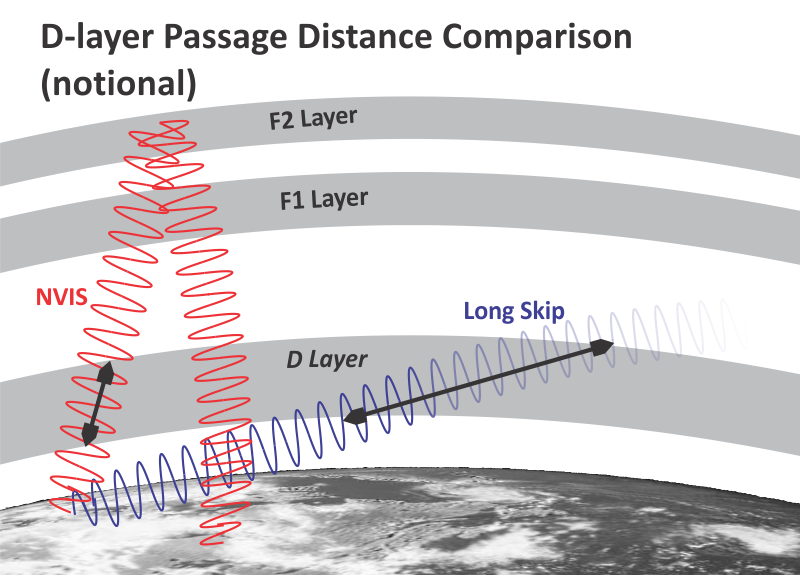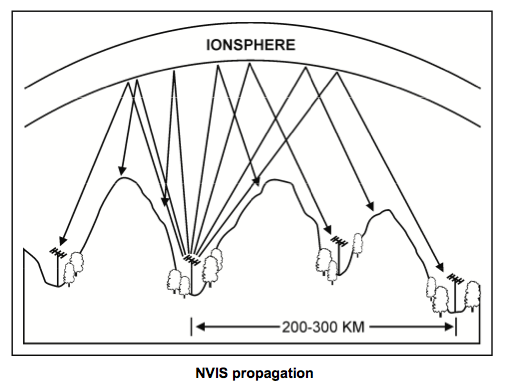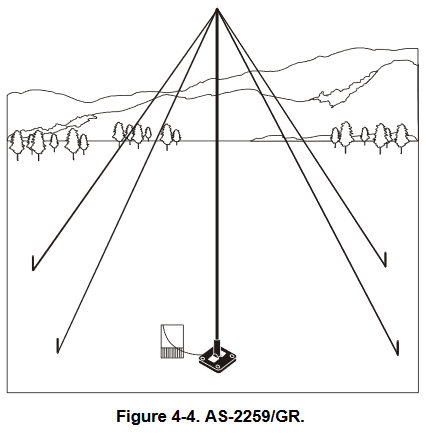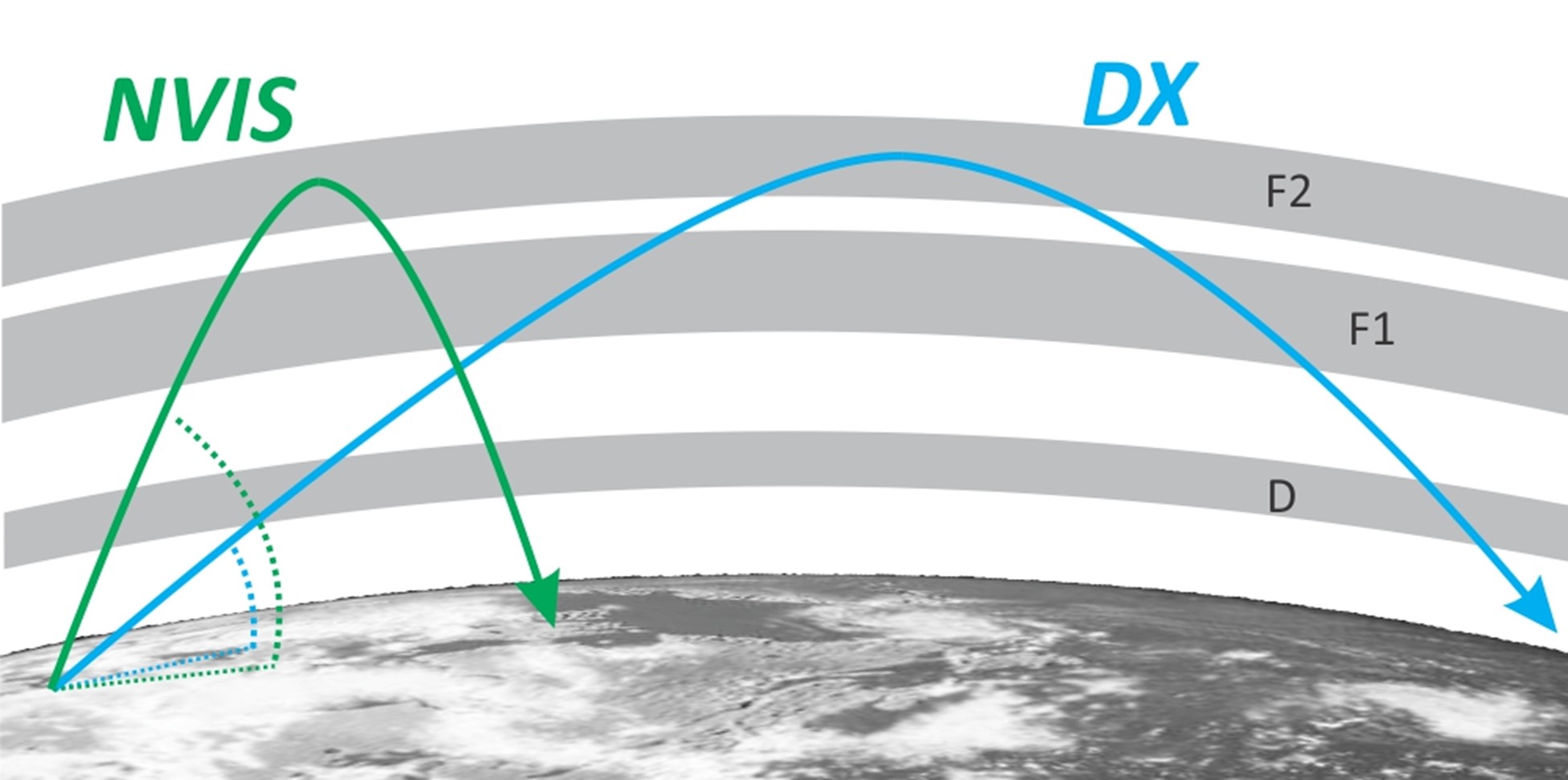Near Vertical Incidence Skywave (NVIS) is a technique used in radio communication to achieve short-range communication over distances of up to a few hundred miles. It involves sending radio waves nearly straight up into the ionosphere, where they are refracted or bent back towards the Earth, allowing for communication over shorter distances.
The term “near vertical incidence” refers to the angle at which the radio waves are sent towards the ionosphere. Instead of the usual practice of sending radio waves at an angle of 30 degrees or more, in NVIS, the waves are sent at an angle of 80 to 90 degrees. This nearly vertical angle causes the radio waves to penetrate the ionosphere, and rather than being reflected or scattered as with conventional ionospheric propagation, the waves are bent back towards the Earth.

The result of this bending of radio waves is that they travel over a relatively short distance, typically up to a few hundred miles, making NVIS ideal for communication over short-range distances. This technique is commonly used by the military, emergency responders, and other organizations that require reliable communication over a limited area.
Significant increases in communication will obviously be realized when both the transmitting station and the receiving station use NVIS configuration for their antennas.

NVIS is most useful in mountainous areas where line-of-sight propagation is ineffective, or when the communication distance is beyond the 80 km (50 miles) range of groundwave (or the terrain is so rugged and barren that groundwave is not effective), and less than the 500–2,400 km (300–1,500 miles) range of lower-angle sky-wave propagation.
According to Wikipedia:
The most reliable frequencies for NVIS communications are between 1.8 MHz and 8 MHz. Above 8 MHz, the probability of success begins to decrease, dropping to near zero at 30 MHz. Usable frequencies are dictated by local ionospheric conditions, which have a strong systematic dependence on geographical location. Common bands used in amateur radio at mid-latitudes are 3.5 MHz at night and 7 MHz during daylight, with experimental use of 5 MHz (60m) frequencies. During winter nights at the bottom of the sunspot cycle, the 1.8 MHz band may be required. Broadcasting uses the tropical broadcast bands between 2.3–5.06 MHz, and the international broadcast bands between 3.9 and 6.2 MHz. Military NVIS communications mostly take place on 2–4 MHz at night, and 5–7 MHz during daylight.
Optimum NVIS frequencies tend to be higher towards the tropics and lower towards the arctic regions. They are also higher during high sunspot activity years. The usable frequencies change from day to night, because sunlight causes the lowest layer of the ionosphere, called the D layer, to increase, causing attenuation of low frequencies during the day while the maximum usable frequency (MUF) which is the critical frequency of the F layer rises with greater sunlight. Real time maps of the critical frequency are available. Use of a frequency about 15% below the critical frequency should provide reliable NVIS service. This is sometimes referred to as the optimum working frequency or FOT.
Depending on the specific requirements, various antennas (i.e. Sloper, T2FD, Dipole) can be used for NVIS communication, with horizontal dipoles or inverted V dipoles at about 1 /5 wavelength above ground giving the best results on transmit and at about 1 /6 wavelength on receive, according to military sources and an extensive study by Dutch researchers.

From my time in Army MARS I can personally vouch for a low to the ground (10 to 20 feet off ground) full wave 80m horizontal loop using a 4:1 balun and coax feed. But another great alternative that is very easy to build, deploy and store, is the the AS-2259 military type antenna. The antenna consists of two ‘inverted V’-shaped dipoles and four dipole wires also serve as guy rope for the antenna mast. To the left is a picture of how the AS-2259 is deployed and below are two documents on how to build an AS-2259.
Overall, NVIS is a valuable technique for achieving reliable communication over short-range distances, particularly in areas where traditional communication methods may be unreliable or unavailable.

